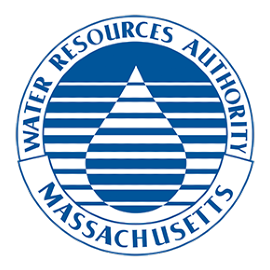Download your report and letter
City of Peabody
Department of Public Services
Public Water Supply
# 3229000
Dear Customer,
Peabody’s drinking water is mainly supplied by the Bob Walsh and Winona Water Treatment Plants. MWRA provided 35% of supplemental drinking water during high water demand months. There are four water storage tanks in the distribution system that provide storage, pressure, and fire protection. A voluntary water restriction continues to be in effect, and we ask our customers to practice conservation measures. For further information on Peabody’s water quality, or to learn about public meetings, contact the Peabody Public Services Department at (978) 536-0600 or go to: peabody-ma.gov/public%20services.html.
Water Treatment: Walsh and Winona WTPs implement the following treatment steps: 1) Coagulation and sedimentation, which removes particles from the water through flocculation, then settling and filtration, which removes the remaining particles out of the water 2) Primary disinfection, which uses free chlorine to kill the harmful microbes, and secondary disinfection, which uses monochloramine to control biological activity in the distribution system, and; 3) Fluoride is added to our drinking water for dental health. Additionally, Walsh pretreats iron and manganese in source water using oxidation by free chlorine, which will be changed to potassium permanganate in 2023. Winona WTP project is completed, and Aeration, DAF, GAC filtration, and sodium permanganate pretreatment have been added.
Source of Water: Winona water (42% of total) is pumped from Winona Pond. Walsh water is pumped from Suntaug Lake (32% of total) and Spring Pond (26% of total). The source for Suntaug Lake and Winona Pond is the Ipswich River. Under MassDEP’s Water Management Act Regulations, withdrawing water from the Ipswich River is only allowed during winter and spring months. The DEP has characterized our surface water source susceptibility as moderate to high. For more information, please visit: www.mass.gov/service-details/the-source-water-assessment-protection-swap-program. Peabody has initiated a Clean and Sustainable Water Future Use Plan. We continue to use Solitude Lake Management for the prevention of seasonal algal growth that can cause taste and odor issues.
Lead and Copper: Peabody’s water was tested for lead and copper in August 2022 at 30 homes and 2 schools. The 90th percentile for all lead samples results was 2.64 parts per billion (ppb) below the lead Action Level of 15 ppb. The 90th for Copper levels were 92.6 ppb, below the copper action level of 1300 ppb. The City has also removed 48 lead goosenecks as part of the Lead Service Line Replacement Program. Sample results are below.
| Date | Range | 90% Value | Action Level | MCLG | Samples Over Action Level | |
| 2/10/22 | Lead (ppb) | 0.0-1.81 | 1.19 | 15 | 0 | 0 |
| 2/10/22 | Copper (ppb) | 6.91-106 | 81.3 | 1300 | 1300 | 0 |
| 8/24/22 | Lead (ppb) | 0.1-4.61 | 2.64 | 15 | 0 | 0 |
| 8/24/22 | Copper (ppb) | 3.1-182 | 92.6 | 1300 | 1300 | 0 |
Results from sampling at our two treatment plants and distribution system are below.
| Walsh Results | Winona Results | |||||||
| Contaminant | MCL | MCLG | Range of Detects | Average | Range of Detects | Average | Violation | Possible Sources |
| Barium (ppm) | 2 | 2 | 0.018 | 0.018 | 0.024 | 0.024 | NO | Common mineral in nature |
| Fluoride (ppm) | 4 | 4 | 0-0.36 | 0.14 | 0.11-0.5 | 0.34 | NO | Additive for dental health |
| PFAS6 -1 | 20 | N/A | 6.03-15.2 | 9.7 | 0-9.7 | 5.5 | NO | Industrial sources, Fire fighting |
| Arsenic | 1000 | 10 | 0.4 | 0.4 | 0.65 | 0.4 | NO | Erosion of natural deposits |
| Sodium (ppm) | N/A | N/A | 69 | 69 | 67 | 67 | NO | Naturally present in environment |
| Turbidity | TT=.3NTU | N/A | 0.02-0.29 | 0.09 | 0.02-0.29 | 0.11 | NO | Soil runoff |
| %TT < 1.0 NTU | 100% | 100% | 100% | 100% | NO | |||
| Unregulated or Secondary Contaminant | Date Collected | Range Detected | Average Detected | SMCL | ORSG | Possible Sources |
| Manganese (ppb) | 3/1/22 | 3.0-154 | 38.1 | 50 | 300 | Erosion of natural deposits |
| Samples From The Distribution System | ||||||
| Contaminant | MCL | MCLG | Average Level | Range of Detects | Violation | Possible Sources |
| Total Chlorine (ppm) | 4 | 4 | 1.98 | 0.46 - 2.97 | NO | Water disinfectant |
| Nitrate (ppm) -2 | 10 | 10 | 0.45 | 0.008 - 0.45 | NO | Erosion of natural deposits |
| Nitrite (ppm) -2 | 1 | 1 | 0.32 | 0 - 0.32 | NO | By-product of disinfection |
| Haloacetic acids - 5 (ppb) | 60 | N/A | 29.16 | 23.45 - 37.54 | NO | By-product of disinfection |
| Total Trihalomethanes (ppb) | 80 | N/A | 36.4 | 23.19 - 53.11 | NO | By-product of disinfection |
1 – For more information: https://www.mass.gov/info-details/per-and-polyfluoroalkyl-substances-pfas
2 - Highest level reported as required.
Updated June 8, 2023
